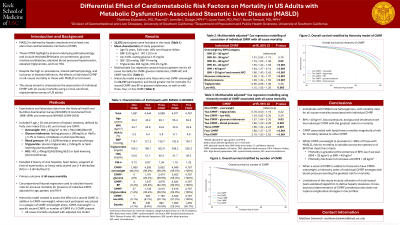Monday Poster Session
Category: Liver
P2960 - Differential Effect of Cardiometabolic Risk Factors on Mortality in US Adults with Metabolic Dysfunction Associated Steatotic Liver Disease (MASLD)
Monday, October 28, 2024
10:30 AM - 4:00 PM ET
Location: Exhibit Hall E

Has Audio

Matthew Dukewich, MD, PharmD
Keck School of Medicine of the University of Southern California
Los Angeles, CA
Presenting Author(s)
Matthew Dukewich, MD, PharmD, Jennifer L. Dodge, MPH, Liyun Yuan, MD, PhD, Norah A. Terrault, MD, MPH
Keck School of Medicine of the University of Southern California, Los Angeles, CA
Introduction: MASLD is defined by abnormalities in cardiometabolic risk factors (CMRF), emphasizing a shared pathophysiology. Characterizing the influence of individual CMRFs on mortality among persons with MASLD can inform our understanding of clinical trajectory and phenotypes and guide prioritization of interventions to mitigate risk.
Methods: Participants from the National Health and Nutrition Examination Survey (NHANES) III (1988-1994) and continuous NHANES (1999-2018) were linked to mortality data through 2019. Adults >20 years of age, without heavy alcohol use, viral hepatitis, or history of heart failure or HIV were included. MASLD was defined by Fatty Liver Index >60 and ≥1 CMRF. CMRF included overweight (BMI >25 kg/m2, WC >94cm[M] >80cm[F]), prediabetes/diabetes (DM, fasting glucose >100mg/dL, A1c >5.7%, history of diabetes or pharmacotherapy), blood pressure (BP, systolic >130mmHg, diastolic >85mmHg, history of hypertension or pharmacotherapy), triglycerides (triglycerides >150 mg/dL or pharmacotherapy), or HDL (HDL <40mg/dL(M) <50mg/dL(F) or pharmacotherapy). Cox regression assessed risk of all-cause mortality, using NHANES survey population weighting.
Results: Adults with MASLD (mean age 50 years, 53% male) had mean BMI of 34 kg/m2 and median of 3 CMRF (IQR 2-4): 99.5% overweight, 55.2% DM, 58.0% BP, 66.8% elevated triglycerides, and 39.5% low HDL. In univariable analysis of only those with overweight CMRF, triglycerides were not associated (HR 1.02, [0.93-1.12], p=0.61), and HDL (HR 1.13, [1.03-1.23], p=0.01), DM (HR 1.35, [1.24-1.46], p< 0.001), and BP (HR 1.43, [1.28-1.60], p< 0.001] were associated with greater risk of mortality. Multivariable Cox regression using this hierarchy of CMRF showed mortality increased with number of CMRF, but among those with 2 CRMF, overweight plus DM (aHR 1.59, p=0.02) or BP (aHR 1.64, p=0.001) conferred higher mortality but HDL (aHR 1.21, p=0.46) and triglycerides (aHR 0.86, p=0.51) did not (TABLE).
Discussion: In US adults with MASLD, essentially all were overweight/obese, and the presence of additional CMRF were associated with progressively greater risk for mortality. Importantly, among those meeting two CMRF, blood pressure as well as glucose abnormalities conferred the greatest risks for mortality, suggesting a prioritization of these metabolic comorbidities among persons with MASLD. These findings highlight that the presence of individual CMRF may be useful in refining clinical phenotypes of MASLD.
Note: The table for this abstract can be viewed in the ePoster Gallery section of the ACG 2024 ePoster Site or in The American Journal of Gastroenterology's abstract supplement issue, both of which will be available starting October 27, 2024.
Disclosures:
Matthew Dukewich, MD, PharmD, Jennifer L. Dodge, MPH, Liyun Yuan, MD, PhD, Norah A. Terrault, MD, MPH. P2960 - Differential Effect of Cardiometabolic Risk Factors on Mortality in US Adults with Metabolic Dysfunction Associated Steatotic Liver Disease (MASLD), ACG 2024 Annual Scientific Meeting Abstracts. Philadelphia, PA: American College of Gastroenterology.
Keck School of Medicine of the University of Southern California, Los Angeles, CA
Introduction: MASLD is defined by abnormalities in cardiometabolic risk factors (CMRF), emphasizing a shared pathophysiology. Characterizing the influence of individual CMRFs on mortality among persons with MASLD can inform our understanding of clinical trajectory and phenotypes and guide prioritization of interventions to mitigate risk.
Methods: Participants from the National Health and Nutrition Examination Survey (NHANES) III (1988-1994) and continuous NHANES (1999-2018) were linked to mortality data through 2019. Adults >20 years of age, without heavy alcohol use, viral hepatitis, or history of heart failure or HIV were included. MASLD was defined by Fatty Liver Index >60 and ≥1 CMRF. CMRF included overweight (BMI >25 kg/m2, WC >94cm[M] >80cm[F]), prediabetes/diabetes (DM, fasting glucose >100mg/dL, A1c >5.7%, history of diabetes or pharmacotherapy), blood pressure (BP, systolic >130mmHg, diastolic >85mmHg, history of hypertension or pharmacotherapy), triglycerides (triglycerides >150 mg/dL or pharmacotherapy), or HDL (HDL <40mg/dL(M) <50mg/dL(F) or pharmacotherapy). Cox regression assessed risk of all-cause mortality, using NHANES survey population weighting.
Results: Adults with MASLD (mean age 50 years, 53% male) had mean BMI of 34 kg/m2 and median of 3 CMRF (IQR 2-4): 99.5% overweight, 55.2% DM, 58.0% BP, 66.8% elevated triglycerides, and 39.5% low HDL. In univariable analysis of only those with overweight CMRF, triglycerides were not associated (HR 1.02, [0.93-1.12], p=0.61), and HDL (HR 1.13, [1.03-1.23], p=0.01), DM (HR 1.35, [1.24-1.46], p< 0.001), and BP (HR 1.43, [1.28-1.60], p< 0.001] were associated with greater risk of mortality. Multivariable Cox regression using this hierarchy of CMRF showed mortality increased with number of CMRF, but among those with 2 CRMF, overweight plus DM (aHR 1.59, p=0.02) or BP (aHR 1.64, p=0.001) conferred higher mortality but HDL (aHR 1.21, p=0.46) and triglycerides (aHR 0.86, p=0.51) did not (TABLE).
Discussion: In US adults with MASLD, essentially all were overweight/obese, and the presence of additional CMRF were associated with progressively greater risk for mortality. Importantly, among those meeting two CMRF, blood pressure as well as glucose abnormalities conferred the greatest risks for mortality, suggesting a prioritization of these metabolic comorbidities among persons with MASLD. These findings highlight that the presence of individual CMRF may be useful in refining clinical phenotypes of MASLD.
Note: The table for this abstract can be viewed in the ePoster Gallery section of the ACG 2024 ePoster Site or in The American Journal of Gastroenterology's abstract supplement issue, both of which will be available starting October 27, 2024.
Disclosures:
Matthew Dukewich: GlaxoSmithKline – Stock Options.
Jennifer Dodge indicated no relevant financial relationships.
Liyun Yuan: Genfit – Grant/Research Support. Intercept – Grant/Research Support.
Norah Terrault: Bristol Myers Squibb – Grant/Research Support. Durect – Grant/Research Support. Eiger – Grant/Research Support. Elsevier – Royalties. Genentech – Grant/Research Support. Gilead – Grant/Research Support. GlaxoSmithKline – Grant/Research Support. Helio – Grant/Research Support. ImmunoCore – Grant/Research Support.
Matthew Dukewich, MD, PharmD, Jennifer L. Dodge, MPH, Liyun Yuan, MD, PhD, Norah A. Terrault, MD, MPH. P2960 - Differential Effect of Cardiometabolic Risk Factors on Mortality in US Adults with Metabolic Dysfunction Associated Steatotic Liver Disease (MASLD), ACG 2024 Annual Scientific Meeting Abstracts. Philadelphia, PA: American College of Gastroenterology.

